A Brief History of the Double Stroller
-
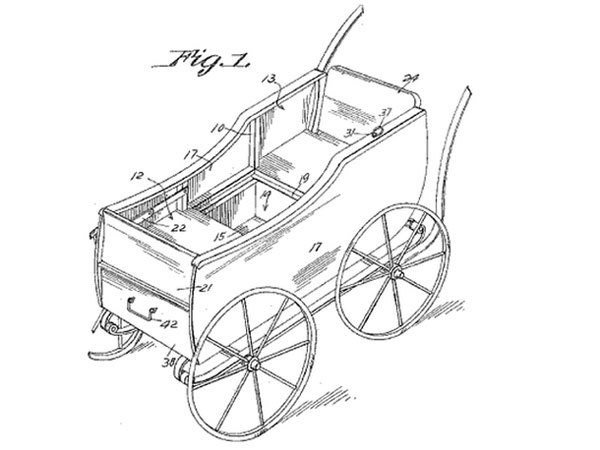 Courtesy of the United States Patent Office.
Courtesy of the United States Patent Office.The early years
The date of the original double stroller is unknown, but the device most likely came about in the late 19th century, when specialized baby products of all kinds were becoming more widely available and the emergence of city parks and paved sidewalks helped to popularize the leisurely family stroll. Among the earliest references comes this one from an 1881 novel called What the Angels Saw on Christmas Eve, in which one character finds the entrance to his home "blocked by a double baby carriage” that had helped to convey a detachment of young visitors.
Some of the earliest models were essentially extra-wide or extra-long single strollers, and usually comprised two small benches contained within a wagonlike contraption. As Joseph B. Schaefer specified in his patent for the 1917 model shown here, “The primary object of the invention is the provision of a carriage body of this character wherein either twins or two babies of different ages can be easily placed and conveniently held therein without discomfort to either one or both and the operator of the carriage.”
-
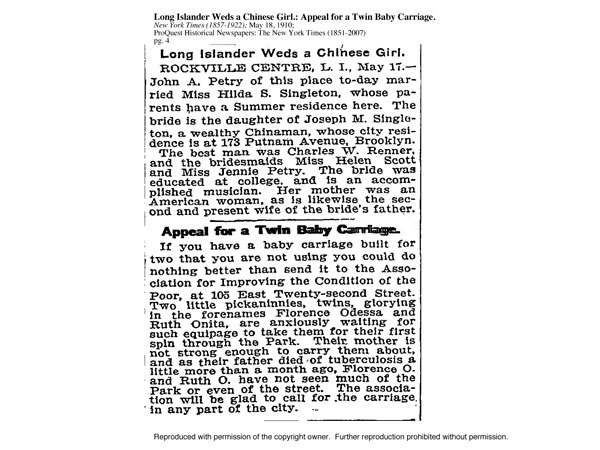 The CREDIT: New York Times.
The CREDIT: New York Times.Strollers for the poor
Early twin strollers seem to have been restricted to the leisure class. In a 1913 article that appeared in The Independent, social reformer Jacob Riis tells the story of a poor young mother who had no way of taking her twins with her to the market but also didn’t want to leave them home alone. Riis put an appeal in the paper asking for a baby carriage big enough for twins. “But who do you suppose has such a baby carriage to give away?” he wondered. The story had a happy ending: Shortly after placing the ad, a procession of baby carriages appeared at the woman’s home. He wrote, “[The strollers] were empty and all of them were of double girth—seven twin perambulators, all labeled and consigned to number 48. It was New York’s reply to our appeal.”
The New York Times classified ad shown here was published in 1910.
-
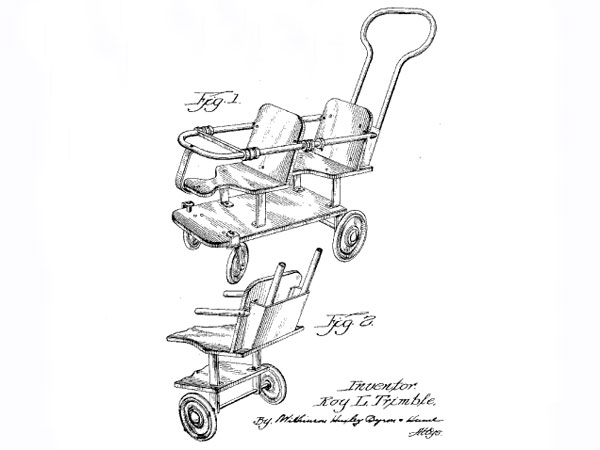 Courtesy of Unites States Patent Office.
Courtesy of Unites States Patent Office.Twin strollers for the baby boom
Twins born between the First and Second World Wars weren't that likely to have been wheeled around in double strollers. In a somewhat recent article from the Herald Sun about a twins convention, the author describes how an elderly pair of brothers born in 1925 marveled at the “snazzy double prams” in use today.
Rapid population growth in the postwar years created a demand for more efficient baby products, however. A 1948 issue of Popular Mechanics introduced a “double-decker” stroller, in which two children sat one behind and above the other, rather than side-by-side. "Realizing that travel abroad with twin year-old sons wouldn't be easy,” the inventor, Harris W. Jones, eventually got a patent for his device. In 1951, the same magazine reported on the development of the 10-pound, collapsible “suitcase stroller,” which came in a twin model and could even be rigged up with a triplet seat between the handles. The model shown here, from inventor Roy Lane Trimble, has a conventional tandem structure, with two infants seated at the same height, one in front of the other.
-
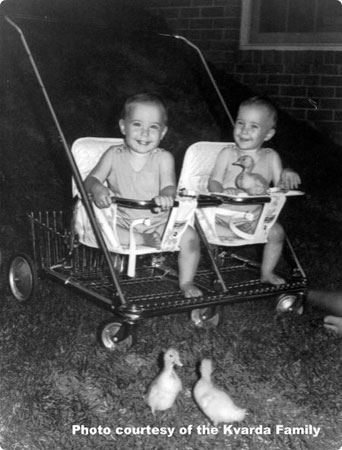 Courtesy the Kvarda family.
Courtesy the Kvarda family.Metal kitty carts on a platform
By the late 1950s, double strollers had become more widespread, but with few improvements over the earlier models. “[Most double strollers] looked liked metal kitty carts on a platform,” explains Ken Maxwell, VP Marketing at Peg Perego. “They were made out of wood or metal—a platform with wheels, that had a fixed seat that stood up about 14 to 16 inches on top of it. It was kind of like a bucket that the children sat in. And the seat itself didn’t fold. [Twin] strollers as we know them today didn’t exist until the late 1960s.” While these strollers were not as convenient as, say, the ones introduced in Popular Mechanics, they may have been cheaper and more comfortable, and they allowed for an under-space to hold things like snacks and other baby gear. (The picture shown here is from 1969.)
-
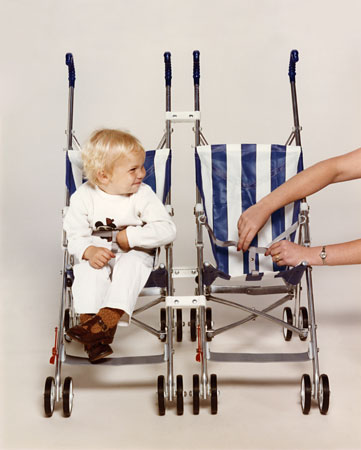 Image courtesy of Maclaren.
Image courtesy of Maclaren.The collapsible twin stroller
After watching his daughter struggle with her own children’s pushchair, British design engineer Owen Maclaren developed the revolutionary idea of creating a lightweight baby buggy with a collapsible support system. As outlined in the book Century Makers, a history of design breakthroughs, Maclaren filed for a patent for his “Umbrella Stroller” in 1966. At first, this was a single-infant stroller, but it was easy to add a second unit to the lightweight contraption. Today, the modern version of the twin umbrella stroller is sold in more than 50 countries throughout the world.
-
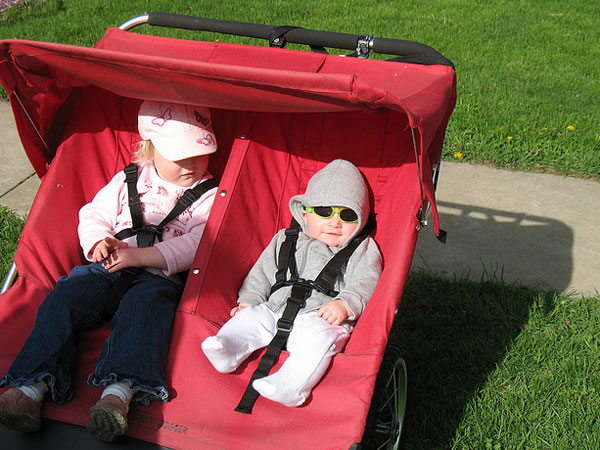 Photograph by Matt McGuire via CREDIT: Flickr.
Photograph by Matt McGuire via CREDIT: Flickr.Modern versions
Nowadays, we see all different types of double strollers. In 1986, Baby Jogger released The Twinner, shown here, as the first jogging stroller made for two children. A light, wieldable version of the classic tandem stroller has become one of the most popular choices among parents of twins.
-
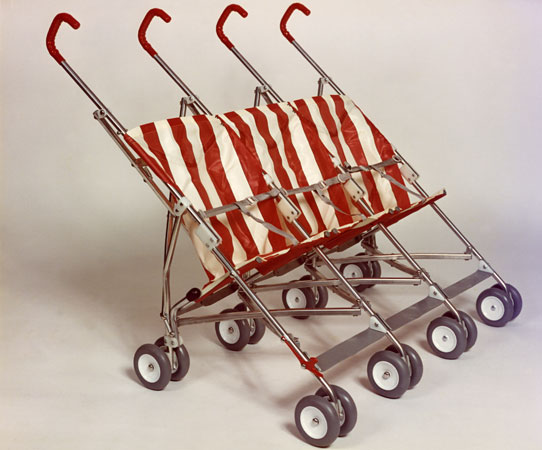 Image courtesy of Maclaren.
Image courtesy of Maclaren.Triple strollers and more
The dramatic rise in IVF-related multiple births that started in the early 1980s brought an increasing demand for strollers that could accommodate more than two riders. Maclaren released its first Triple Seat Umbrella Fold Buggy in 1981, and triple strollers have only gotten more elaborate since.
Kate Gosselin, star of the reality show Jon & Kate Plus 8, has been seen pushing around a six-seated stroller. As technology becomes increasingly advanced—both in manufacturing and fertility—who knows what strollers will look like in the future?